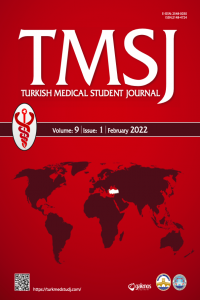THE EFFECT OF 5-FU AND RUXOLITINIB ON MITOCHONDRIAL APOPTOSIS IN GLIOBLASTOMA U87 CELL LINE
THE EFFECT OF 5-FU AND RUXOLITINIB ON MITOCHONDRIAL APOPTOSIS IN GLIOBLASTOMA U87 CELL LINE
5-Fluorouracil, Ruxolitinib glioblastoma, apoptosis, JAK/STAT pathway,
___
- 1. Bedini A, Baiula M, Vincelli G et al. Nociceptin/orphanin FQ antagonizes lipopolysaccharide-stimulated proliferation, migration and inflammatory signaling in human glioblastoma U87 cells. Bio- chem Pharmaol 2017;140:89-104.
- 2. Batash R, Asna N, Schaffer P et al. Glioblastoma multiforme, diagnosis and treatment; recent literature review. Curr Med Chem 2017;24(27):3002-9.
- 3. Alifieris C, Trafalis DT. Glioblastoma multiforme: pathogenesis and treatment. Pharmacol Ther 2015;152:63-82.
- 4. Leelakanok N, Geary S, Salem A. Fabrication and use of poly(d,l- lactide-co-glycolide)-based formulations designed for modified re- lease of 5-Fluorouracil. J Pharm Sci 2018;107(2):513-28
- 5. Diasio RB, Harris BE. Clinical pharmacology of 5-Fluorouracil. Clin Pharmacokinet 1989;16(4):215-37.
- 6. Akca H, Ozes ON. Antitumor effects of TNF-β, 5-FU and their combinations on cervical carcinoma cell lines. 2002;32:127-32.
- 7. Goker Bagca B, Avci CB. Ruxolitinib and effect mechanism. FNG & Demiroğlu Bilim Tıp Dergisi 2016;2(2):153-7.
- 8. LiverTox: Clinical and Research Information on Drug-Induced Liver Injury [Internet]. Bethesda (MD): National Institute of Dia- betes and Digestive and Kidney Diseases; 2012. Ruxolitinib. (Up- dated 2018 Jun 4). Available from: URL: https://www.ncbi.nlm.nih. gov/books/NBK548534/pdf/Bookshelf_NBK548534.pdf.
- 9. Delen E, Doganlar O, Doganlar ZB et al. Inhibition of the inva- sion of human glioblastoma U87 cell line by ruxolitinib: a molec- ular player of miR-17 and miR-20a regulating JAK/STAT pathway. Turk Neurosurg 2020;30(2):182-9.
- 10. Xu J, JiL D, Xu LH. Lead-induced apoptosis in PC 12 cells: Involvement of p53, Bcl-2 family and caspase-3. Toxicol Lett 2006;166(2):160-7.
- 11. Erdogan MK, Agca CA, Askin H. Enhanced antiproliferative and apoptotic effects of 5-fluorouracil by combined with Pistacia eurycarpa extracts on human colorectal cancer cells. BioDiCon 2019;12(1):27-38.
- 12. Winter RN, Kramer A, Borkowski A et al. Loss of caspase-1 and caspase-3 protein expression in human prostate cancer. Cancer Res 2001;61(3):1227-32.
- 13. Teitz T, Wei T, Valentine MB et al. Caspase 8 is deleted or si- lenced preferentially in childhood neuroblastomas with amplifica- tion of MYCN. Nat Med 2000;6(5):529-35.
- 14. Shivapurkar N, Toyooka S, Eby MT, et al. Differential inactiva- tion of caspase-8 in lung cancers. Cancer Biol Ther 2002;1(1):65–9.
- 15. Kasibhatla, S. Acridine Orange/Ethidium Bromide (AO/EB) Staining to Detect Apoptosis. Cold Spring Harbor Protocols, 2006 (21). doi:10.1101/pdb.prot4493
- 16. Jatiani SS, Baker SJ, Silverman LR et al. Jak/STAT pathways in cytokine signaling and myeloproliferative disorders: approaches for targeted therapies. Genes Cancer 2010;1(10):979-93.
- 17. Owen KL, Brockwell NK, Parker BS. JAK-STAT signaling: a double-edged sword of immune regulation and cancer progression. Cancers (Basel) 2019;11(12):2002.
- 18. Imada K, Leonard WJ. The JAK-STAT pathway. Molecular Im- munology 2000;37:1-11.
- 19. Schindler C, Levy DE, Decker T. JAK-STAT signaling: from interferons to cytokines. Journal of Biological Chemistry 2007;282(28):20059-63.
- 20. Masjedi A, Hashemi V, Hojjat-Farsangi M et al. The significant role of interleukin-6 and its signaling pathway in the immuno- pathogenesis and treatment of breast cancer. Biomedicine & Phar- macotherapy 2018;108:1415-24.
- 21. Rose-John S. IL-6 trans-signaling via the soluble IL-6 receptor: importance for the pro-inflammatory activities of IL-6. Int J Biol Sci 2012;8(9):1237–47.
- 22. Yu H, Lee H, Herrmann A et al. Revisiting STAT3 signalling in cancer: new and unexpected biological functions. Nat Rev Cancer 2014;14(11):736-46.
- ISSN: 2148-4724
- Başlangıç: 2014
- Yayıncı: Trakya Üniversitesi
JUVENILE POLYP FROM SYMPTOM TO DIAGNOSIS AND THE ROLE OF ULTRASONOGRAPHY: A CASE REPORT
Berkin ERSOY, Özdal ERSOY, Haluk AKMAN, Füsun BABA
THE EFFECT OF 5-FU AND RUXOLITINIB ON MITOCHONDRIAL APOPTOSIS IN GLIOBLASTOMA U87 CELL LINE
Gonca AKSU, Oğuzhan DOĞANLAR, Zeynep Banu DOĞANLAR
Elif CENGİZ, Fevzi Oktay ŞİŞMAN, Beliz KOÇYİĞİT, Mehmet Gürkan ARIKAN, Tevfik AKTOZ
THE FOURTH HORSEMAN OF 21ST CENTURY: COVID-19 PANDEMIC
İnci KADRİBEY, Fatih Erkan AKAY
PATHOPHYSIOLOGY, CLINICAL FEATURES AND TREATMENT OF MICROVASCULAR ANGINA: A REVIEW
Hasan Selçuk ÖZKAN, Meral KAYIKÇIOĞLU
MYOCARDIAL INFARCTION DIAGNOSIS AND CARDIAC TROPONINS
Berra KURTOĞLU, Burcu ERKILIÇ, Dilay Yağmur GÜRSEL, Gülsüm ARSLAN, Ogün BACAKSIZOĞLU, Pınar ALTUNDAL, Selin KARA, Yasemin ARDIÇOĞLU
INVESTIGATION OF THE PARAMETERS THAT MAY PREDICT HEMODIALYSIS FREQUENCY
Gökhan KIRAL, Alperen Taha CERTEL, Irmak İrem ÖZYİĞİT, Begüm SÖYLEYİCİ, Güray AYGÜN, Cenk GÖKALP
DISTANCE EDUCATION IN MEDICAL SCHOOLS: THE EXPERIENCE AND OPINIONS OF ACADEMICIANS AND STUDENTS
Hilal Sena ÇİFCİBAŞI, Berkay KEF, Irmak İrem ÖZYİĞİT, Sezin SAYIN, Aslı GÖZTEPE, Selis Gülseven GÜVEN, Serkan ATICI
